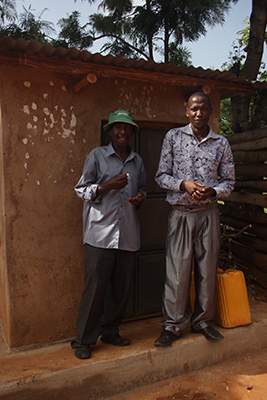ABM Archive Website
THIS WEBSITE CONTAINS ARCHIVE MATERIALS FOR HISTORICAL REFERENCE ONLY
For up-to-date information, including our latest appeals, news, and resources, please visit our current website.
What is a CBO?
 |
| Makakya CBO inspects the impact of their Sand Dam project. © Julianne Stewart/ABM |
September 2016
What is a CBO? Some of you will be familiar with this acronym, but for others it will be new. CBOs, or Community-based Organisations, are what many of us belong to in our own communities. These might be service clubs, or even church groups that do community work. In the developing world, much of the work of development is done by CBOs. Typically, CBOs are funded by larger Non-Government Organisations, or NGOs, who often receive funds from international donors.
In the case of ABM’s program in Eastern Kenya, the Wanzauini Livelihoods Improvement Program, which ABM has been supporting since 2010, this is how it works:
-

Member of the Kalawani CBO with her crops ABM seeks funding from its generous supporters and from the Australian government, which it then sends to its local partner, in this case the Anglican Church of Kenya’s “NGO”, Anglican Development Services, Eastern (ADSE)
- ADSE has a strong skill base in project management, water and sanitation, agriculture, savings and loans and microfinance, government linkages, training and other areas, which they use to link with and build the capacity of local CBOs in areas of greatest poverty
- The CBOs are formed from a number of smaller local self-help groups who might include a mothers’ self-help group, a group of farmers interested in improving their maize production, a group of villagers who want better access to clean water for themselves and their children. ADSE will work with these smaller groups to help them form into a larger CBO, which then gets training in meeting procedure, management and governance, and is eventually registered with the Kenyan government.
Once project funding is secured, the local partner (ADSE) works closely with the CBO to ensure it has the necessary skills to decide on priorities and to implement the project. In the case of Wanzauni, there are two CBOs – Makakya and Kalawani. Both of these CBOs are working hard within their communities to address the root cause of the poverty which in decades past has seen waves of famine spread across the semi-arid farmland of eastern Kenya. This root cause is lack of water.
 |
| Water pumping station in Kalawani. Water from the sand dams is piped here, for locals to come and collect. © Julianne Stewart |
Water shortage has been addressed over the last five years of this project in a number of ways. The most dramatic is the construction of sand dams across dry, sandy riverbeds which are only fed by rains once or twice a year, and in some years not at all. These sand dams are able to store large reservoirs of water within the sand that eventually rises to the height of the cement dam wall. People access this water, either by making shallow wells in the sand, or by pumping water from the sand.
Other means that these CBOs have used to address water shortage include: contouring the hillsides to prevent run-off, learning about and taking up drip irrigation, and planting around 180,000 trees over the last five years to improve the micro climate of the area. This is a huge achievement!
So, the skills training is provided to the CBOs by ADSE, and the funding, and some broader skills training (such as some aspects of program planning, monitoring and evaluation, and measuring of effectiveness) are provided by ABM to ADSE. And the CBOs use their skills to train other community members, and to increase the productivity of their agricultural lands.


